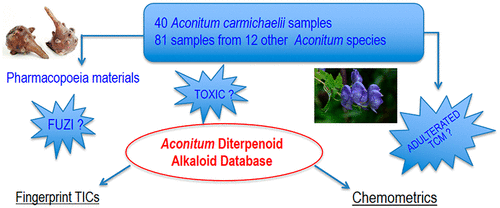当前位置:
X-MOL 学术
›
J. Nat. Prod.
›
论文详情
Our official English website, www.x-mol.net, welcomes your feedback! (Note: you will need to create a separate account there.)
Aconitum Diterpenoid Alkaloid Profiling to Distinguish between the Official Traditional Chinese Medicine (TCM) Fuzi and Adulterant Species Using LC-qToF-MS with Chemometrics
Journal of Natural Products ( IF 5.1 ) Pub Date : 2021-01-26 , DOI: 10.1021/acs.jnatprod.0c00851 Yana Shi 1, 2 , Yi Zhao 3, 4 , Junxiang Qian 2 , Zhiyuan Dong 2 , Guosong Wen 1 , Dake Zhao 5, 6 , Edward J Kennelly 3, 7
Journal of Natural Products ( IF 5.1 ) Pub Date : 2021-01-26 , DOI: 10.1021/acs.jnatprod.0c00851 Yana Shi 1, 2 , Yi Zhao 3, 4 , Junxiang Qian 2 , Zhiyuan Dong 2 , Guosong Wen 1 , Dake Zhao 5, 6 , Edward J Kennelly 3, 7
Affiliation

|
The lateral roots of Aconitum carmichaelii, known in Chinese as fuzi, are officially recognized as a materia medica in the Chinese Pharmacopoeia and used culinarily to prepare herbal soups. A strategy combining UPLC-qToF-MS analysis of A. carmichaelii and its intraspecies and interspecies chemometrics study was developed to examine the distribution of Aconitum marker metabolites. Four diterpenoid alkaloids were recognized to be important markers in fuzi, and another 15 markers were identified to differentiate A. carmichaelii from adulterant species. The detected fuzi markers, mesaconitine (47) and hypaconitine (51), are known to be the principal toxins in this herb, while fuziline (6) and benzoylmesaconine (25) are associated with its medicinal properties. Additional marker compounds have been detected in other Aconitum species that are useful for identifying adulteration. This study provides a useful resource for detecting traditional Chinese medicine (TCM) adulterants and assisting in the quality control of botanical products in TCM and beyond.
更新日期:2021-03-26


























 京公网安备 11010802027423号
京公网安备 11010802027423号